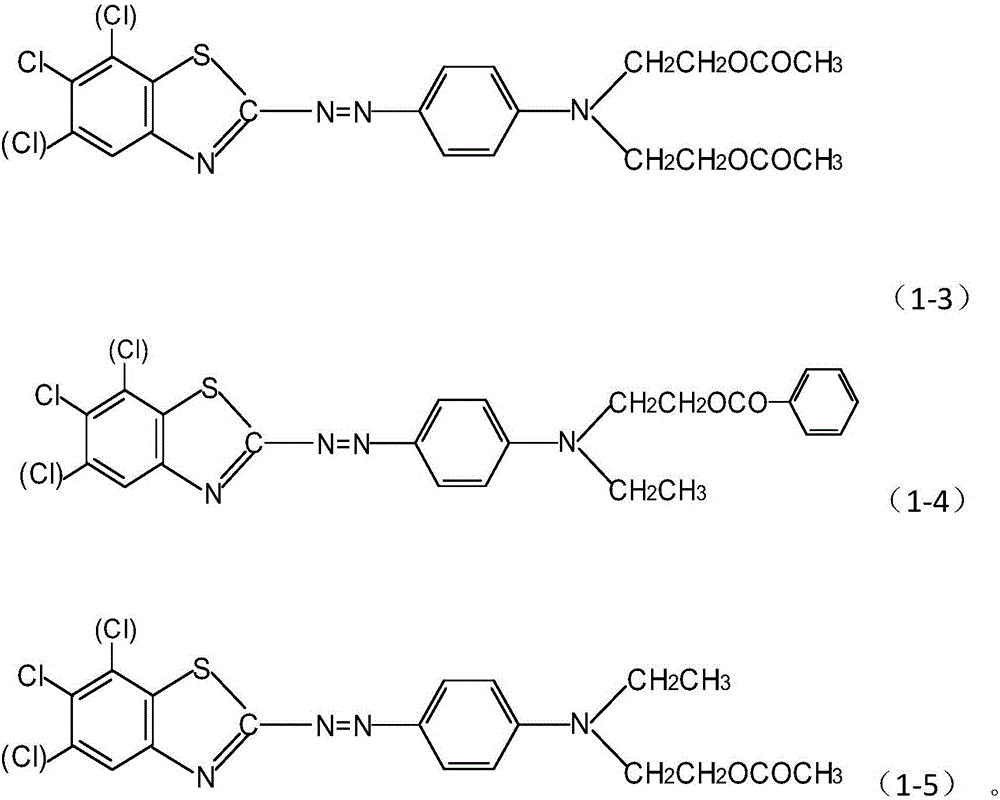Disperse dye composition as well as preparation method and application thereof
A technology of disperse dyes and compositions, applied in dyeing methods, azo dyes, organic dyes, etc., can solve the problems of sludge and parts that are not environmentally friendly, different content of harmful substances in textiles, and carcinogenicity.
- Summary
- Abstract
- Description
- Claims
- Application Information
AI Technical Summary
Problems solved by technology
Method used
Image
Examples
preparation example 1
[0049] (1) Distill 3,4-dichloroaniline in hydrogen chloride solution to obtain 3,4-dichloroaniline hydrochloride solution, then thiourea with ammonium thiocyanate, and close the ring under concentrated sulfuric acid to obtain 2- A sulfuric acid solution of amino-5,6(6,7)-dichlorobenzothiazole;
[0050] (2) Add nitrosylsulfuric acid to the sulfuric acid solution of 2-amino-5,6(6,7)-dichlorobenzothiazole, keep stirring at 35°C for 1 hour, drop into sulfuric acid acidity of 46%, and the temperature is Diazotization reaction in dilute acid at -5~-2°C, dropwise addition time is 5 hours, and keep warm for 2 hours after dropping to obtain diazo component;
[0051] (3) Add water, sulfuric acid, and Pingping to the coupling kettle, add the coupling component N-ethyl-N-cyanoethyl m-toluidine, stir for 30 minutes, add ice and isooctyl alcohol, and control the temperature at -5~ 0°C, add the diazo component dropwise, dropwise for 2.5 hours, control the temperature at 0-5°C and keep it wa...
preparation example 2-5
[0053] The method of Preparation Example 1 was adopted, except that the coupling component N-cyanoethyl-N-acetoxyethylaniline in Preparation Example 1 was replaced by the coupling components shown in Table 1.
[0054] Table 1
[0055]
[0056] Components A contained in the products (I-2)-(I-5) obtained in sequence from Preparation Examples 2-5 are compounds of formulas (1-2)-(1-5) in sequence.
Embodiment 1
[0064] 100 grams of product (I-1), 100 grams of dispersant MF, 95 grams of lignin 85A, and 440 grams of water were added to fully stir, grind with a sand mill, and then spray dry to obtain a disperse dye composition.
PUM
 Login to View More
Login to View More Abstract
Description
Claims
Application Information
 Login to View More
Login to View More - R&D
- Intellectual Property
- Life Sciences
- Materials
- Tech Scout
- Unparalleled Data Quality
- Higher Quality Content
- 60% Fewer Hallucinations
Browse by: Latest US Patents, China's latest patents, Technical Efficacy Thesaurus, Application Domain, Technology Topic, Popular Technical Reports.
© 2025 PatSnap. All rights reserved.Legal|Privacy policy|Modern Slavery Act Transparency Statement|Sitemap|About US| Contact US: help@patsnap.com



